Noise reduction
Contents
Noise reduction#
The simplest way to reduce noise is to slightly blur the image, for example using a gaussian or median filter.
import numpy as np
from skimage.io import imread
from pyclesperanto_prototype import imshow
import matplotlib.pyplot as plt
# load zfish image and extract a channel
zfish_image = imread('../../data/zfish_eye.tif')[:,:,0]
cropped_zfish = zfish_image[630:730, 500:600]
from skimage.filters import median, gaussian
from skimage.morphology import disk
zfish_gaussian = gaussian(cropped_zfish, sigma=2, preserve_range=True)
zfish_median = median(cropped_zfish, footprint=disk(4))
fig, axs = plt.subplots(1, 3, figsize=(10,10))
imshow(cropped_zfish, plot=axs[0])
axs[0].set_title("Original")
imshow(zfish_gaussian, plot=axs[1])
axs[1].set_title("Gaussian")
imshow(zfish_median, plot=axs[2])
axs[2].set_title("Median")
for ax in axs:
ax.axis('off')
plt.tight_layout()
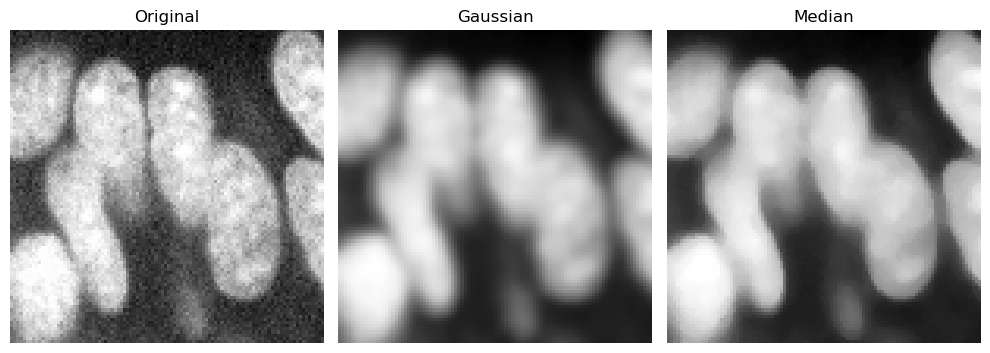
Background removal filters#
There are also background removal filters. If there is a more or less homogeneous intensity spread over the whole image, potentially increasing in a direction, it is recommended to remove this background before segmenting the image.
As example image, we will work with a zebrafish eye data set (Courtesy of Mauricio Rocha Martins, Norden lab, MPI CBG). As you can see, there is some intensity spread around the nuclei we want to segment later on. The source of this background signal is out-of-focus light.
imshow(zfish_image)
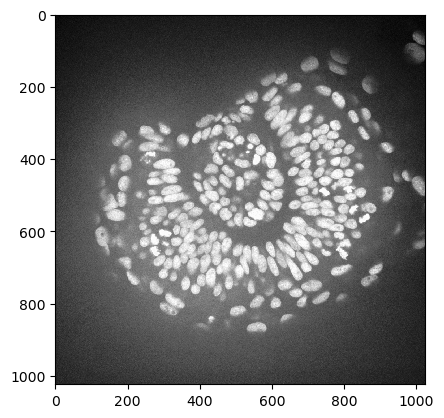
To subtract the background, we need to determine it first. There are several algorithms that are useful for removing inhomogeneous background.
Rolling ball algorithm#
Well known to FIJI users, the rolling-ball algorithm is still widely used to remove background. The radius parameter determines the largest object that should not be considered background.
from skimage.restoration import rolling_ball
background_rolling = rolling_ball(zfish_image, radius=50)
zfish_rolling = zfish_image - background_rolling
fig, axs = plt.subplots(1, 3, figsize=(10,10))
imshow(zfish_image, plot=axs[0])
axs[0].set_title("Original")
imshow(background_rolling, plot=axs[1])
axs[1].set_title("Background (rolling ball)")
imshow(zfish_rolling, plot=axs[2])
axs[2].set_title("Background subtracted")
for ax in axs:
ax.axis('off')
plt.tight_layout()
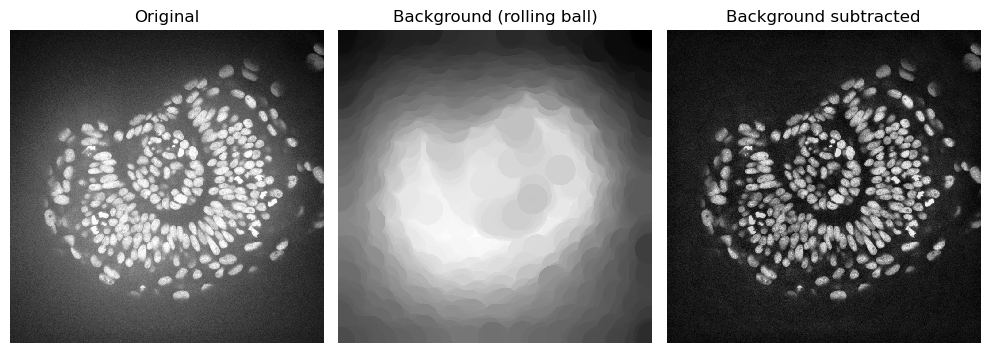
Tophat filter#
The white_tophat filter gives very similar results to the rolling ball algorithm, but is algorithmically much simpler. The footprint parameter determines the largest object that should not be considered background:
from skimage.morphology import disk, white_tophat
zfish_tophat = white_tophat(zfish_image, footprint=disk(50))
background_tophat = zfish_image - zfish_tophat
fig, axs = plt.subplots(1, 3, figsize=(10,10))
imshow(zfish_image, plot=axs[0])
axs[0].set_title("Original")
imshow(background_tophat, plot=axs[1])
axs[1].set_title("Background (tophat)")
imshow(zfish_tophat, plot=axs[2])
axs[2].set_title("Background subtracted")
for ax in axs:
ax.axis('off')
plt.tight_layout()
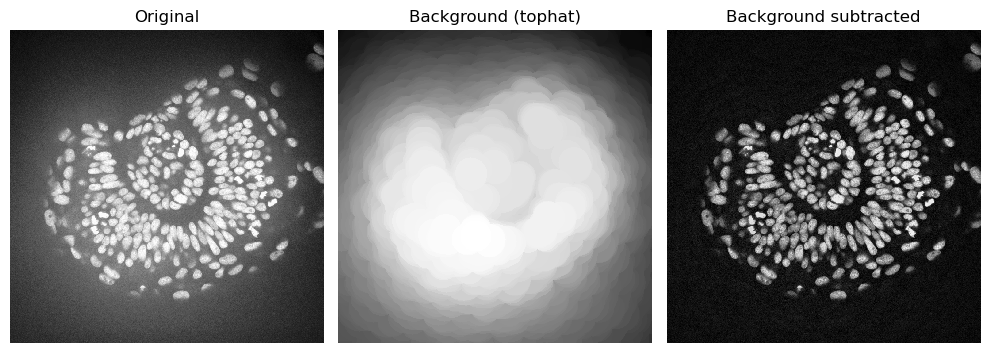
Gaussian blur#
A simple gaussian blur can also be used to estimate the background:
from skimage.filters import gaussian
background_gaussian = gaussian(zfish_image, sigma=50, preserve_range=True)
zfish_gaussian = zfish_image - background_gaussian
fig, axs = plt.subplots(1, 3, figsize=(10,10))
imshow(zfish_image, plot=axs[0])
axs[0].set_title("Original")
imshow(background_gaussian, plot=axs[1])
axs[1].set_title("Background (Gaussian)")
imshow(zfish_gaussian, plot=axs[2])
axs[2].set_title("Background subtracted")
for ax in axs:
ax.axis('off')
plt.tight_layout()
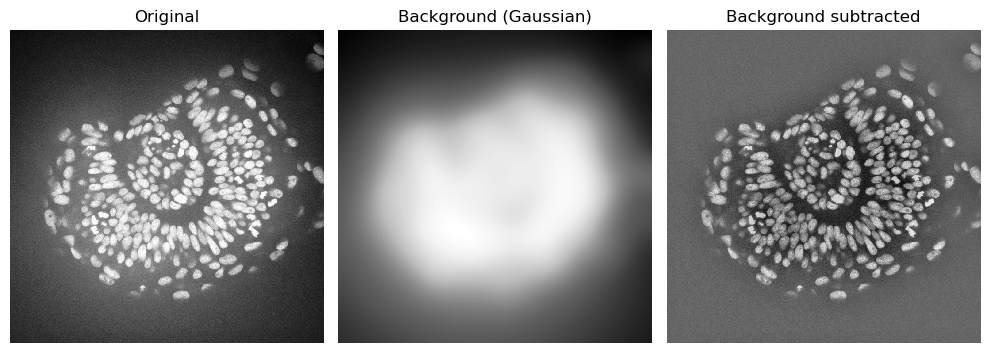
Comparing different algorithms#
Which one is your favorite algorithm?
fig, axs = plt.subplots(2, 2, figsize=(6.67,8))
imshow(zfish_image, plot=axs[0,0])
axs[0,0].set_title("Original")
imshow(zfish_rolling, plot=axs[0,1])
axs[0,1].set_title("Rolling ball")
imshow(zfish_tophat, plot=axs[1,0])
axs[1,0].set_title("Tophat")
imshow(zfish_gaussian, plot=axs[1,1])
axs[1,1].set_title("Gaussian")
for ax in axs.ravel():
ax.axis('off')
plt.tight_layout()
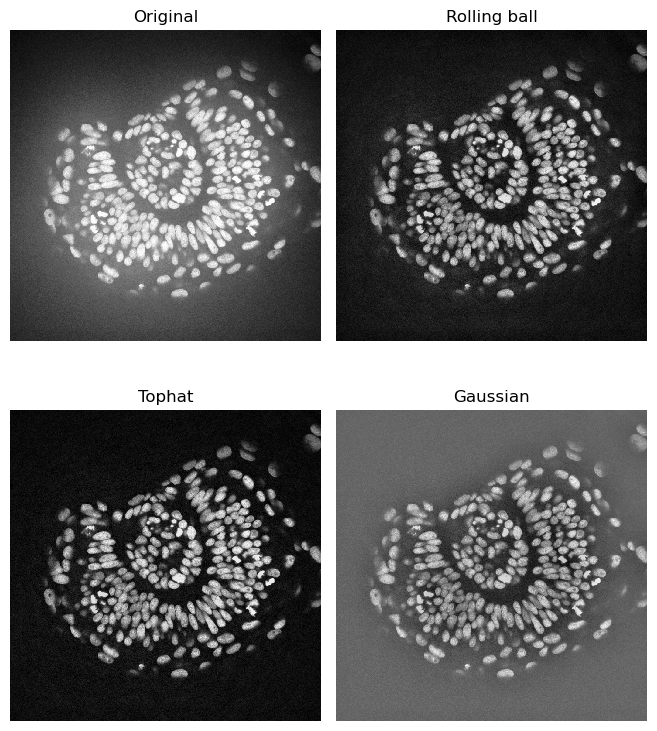
Difference of Gaussians#
In many cases, background subtraction is combined with denoising. The Difference of Gaussians (DoG) performs both operations in one function.
from skimage.filters import difference_of_gaussians
zfish_difference_of_gaussians = difference_of_gaussians(zfish_image, 3, 50)
fig, axs = plt.subplots(1, 3, figsize=(10,10))
imshow(zfish_image, plot=axs[0])
axs[0].set_title("Original")
imshow(background_gaussian, plot=axs[1])
axs[1].set_title("Background (Gaussian)")
imshow(zfish_difference_of_gaussians, plot=axs[2])
axs[2].set_title("Difference of Gaussian")
for ax in axs:
ax.axis('off')
plt.tight_layout()
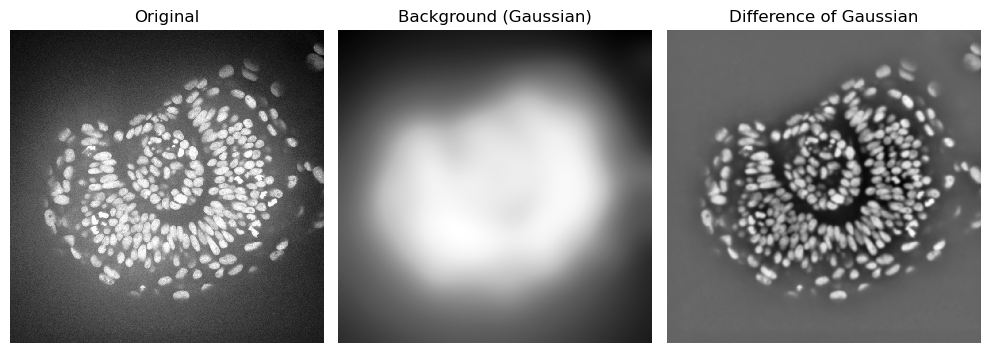
Edge detection#
Edge detection highlights parts of the image where the signal intensity changes strongly.
A common filter for edge detection is the laplace filter
from skimage.filters import laplace
zfish_laplace = laplace(zfish_image, ksize=5)
fig, axs = plt.subplots(1, 2, figsize=(6.67,10))
imshow(zfish_image, plot=axs[0])
axs[0].set_title("Original")
imshow(zfish_laplace, plot=axs[1])
axs[1].set_title("Laplace")
for ax in axs:
ax.axis('off')
plt.tight_layout()
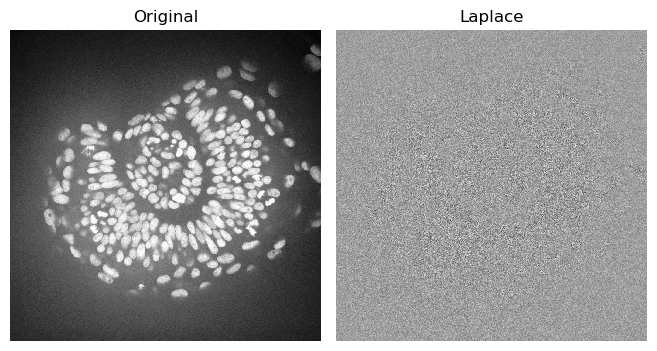
Oops, I guess the image was too noisy. Let’s use what we have learned above and apply the laplacian to an image where we reduced the noise
zfish_gaussian = gaussian(zfish_image, sigma=3)
zfish_laplacian_of_gaussian = laplace(zfish_gaussian)
fig, axs = plt.subplots(1, 3, figsize=(10,10))
imshow(zfish_image, plot=axs[0])
axs[0].set_title("Original")
imshow(zfish_gaussian, plot=axs[1])
axs[1].set_title("Gaussian")
imshow(zfish_laplacian_of_gaussian, plot=axs[2])
axs[2].set_title("Laplacian of Gaussian (LoG)")
for ax in axs:
ax.axis('off')
plt.tight_layout()
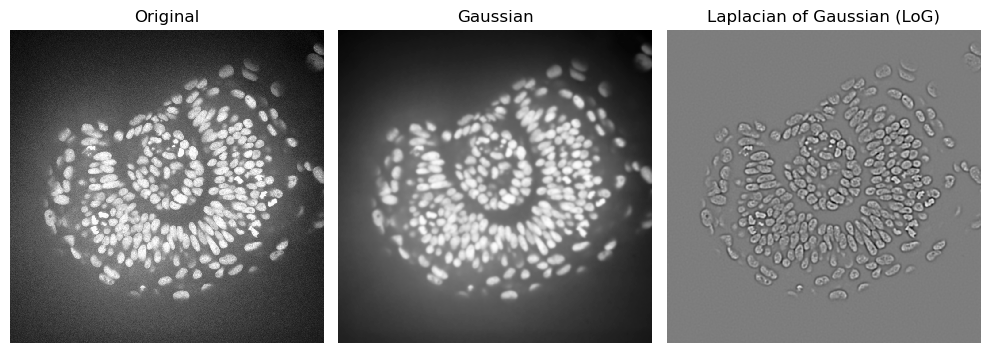
Exercises#
Exercise 1#
compare the different algorithms again but now add min_display_intensity=0 to the parameters of imshow.
Does that change your assessment of the algorithms? What are the implications for further processing of your image?
Exercise 2#
Apply different algorithms and radii to remove the background in the zebrafish eye dataset. Zoom into the dataset using cropping and figure out how to make the background go away optimally.

